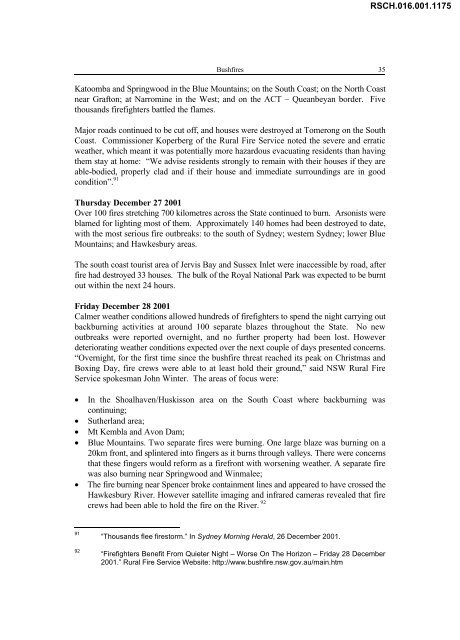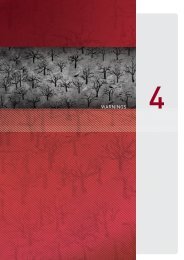RSCH.016.001.1136 - 2009 Victorian Bushfires Royal Commission
RSCH.016.001.1136 - 2009 Victorian Bushfires Royal Commission
RSCH.016.001.1136 - 2009 Victorian Bushfires Royal Commission
You also want an ePaper? Increase the reach of your titles
YUMPU automatically turns print PDFs into web optimized ePapers that Google loves.
RSCH.016.001.1175<br />
<strong>Bushfires</strong> 35<br />
Katoomba and Springwood in the Blue Mountains; on the South Coast; on the North Coast<br />
near Grafton; at Narromine in the West; and on the ACT – Queanbeyan border. Five<br />
thousands firefighters battled the flames.<br />
Major roads continued to be cut off, and houses were destroyed at Tomerong on the South<br />
Coast. <strong>Commission</strong>er Koperberg of the Rural Fire Service noted the severe and erratic<br />
weather, which meant it was potentially more hazardous evacuating residents than having<br />
them stay at home: “We advise residents strongly to remain with their houses if they are<br />
able-bodied, properly clad and if their house and immediate surroundings are in good<br />
condition”. 91<br />
Thursday December 27 2001<br />
Over 100 fires stretching 700 kilometres across the State continued to burn. Arsonists were<br />
blamed for lighting most of them. Approximately 140 homes had been destroyed to date,<br />
with the most serious fire outbreaks: to the south of Sydney; western Sydney; lower Blue<br />
Mountains; and Hawkesbury areas.<br />
The south coast tourist area of Jervis Bay and Sussex Inlet were inaccessible by road, after<br />
fire had destroyed 33 houses. The bulk of the <strong>Royal</strong> National Park was expected to be burnt<br />
out within the next 24 hours.<br />
Friday December 28 2001<br />
Calmer weather conditions allowed hundreds of firefighters to spend the night carrying out<br />
backburning activities at around 100 separate blazes throughout the State. No new<br />
outbreaks were reported overnight, and no further property had been lost. However<br />
deteriorating weather conditions expected over the next couple of days presented concerns.<br />
“Overnight, for the first time since the bushfire threat reached its peak on Christmas and<br />
Boxing Day, fire crews were able to at least hold their ground,” said NSW Rural Fire<br />
Service spokesman John Winter. The areas of focus were:<br />
· In the Shoalhaven/Huskisson area on the South Coast where backburning was<br />
continuing;<br />
· Sutherland area;<br />
· Mt Kembla and Avon Dam;<br />
· Blue Mountains. Two separate fires were burning. One large blaze was burning on a<br />
20km front, and splintered into fingers as it burns through valleys. There were concerns<br />
that these fingers would reform as a firefront with worsening weather. A separate fire<br />
was also burning near Springwood and Winmalee;<br />
· The fire burning near Spencer broke containment lines and appeared to have crossed the<br />
Hawkesbury River. However satellite imaging and infrared cameras revealed that fire<br />
crews had been able to hold the fire on the River. 92<br />
91<br />
92<br />
“Thousands flee firestorm.” In Sydney Morning Herald, 26 December 2001.<br />
“Firefighters Benefit From Quieter Night – Worse On The Horizon – Friday 28 December<br />
2001.” Rural Fire Service Website: http://www.bushfire.nsw.gov.au/main.htm
















